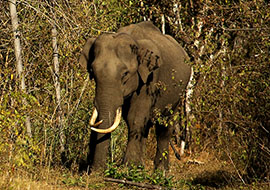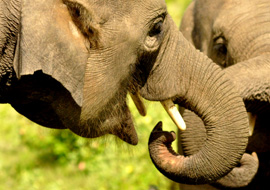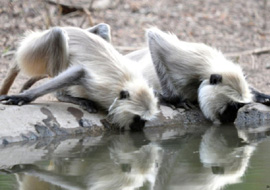

I grew up listening to the jungle stories that my father used to narrate. An ardent wildlife enthusiast and a photographer, my father has conducted several wildlife campaigns and made me part of it right from the time I was seven years old. As a child I always thought we were a family of four – father, mother, jungle and me. Over the years, this bond has only got stronger and I too became a naturalist with a passion for wildlife conservation, writing and photography.
Couple of months back, I was touring Mysore, looking at the ancient architectural marvels. A beautiful city, Mysore is also famous for a bird sanctuary called Ranghanthittu.
 Situated on the banks of Kauvery River, with a 67 sq. km area, Ranghanthittu is 3 Kms away from the historic town Srirangapatna and 14 kms from Mysore. The Sanctuary comprises of six islets, which came into being when a dam across the Kauvery River was built in the 18th century. The ornithologist Dr. Salim Ali observed that the islets formed an important nesting ground for birds, and persuaded the kings of Mysore to declare the area a wildlife sanctuary in 1940.
Situated on the banks of Kauvery River, with a 67 sq. km area, Ranghanthittu is 3 Kms away from the historic town Srirangapatna and 14 kms from Mysore. The Sanctuary comprises of six islets, which came into being when a dam across the Kauvery River was built in the 18th century. The ornithologist Dr. Salim Ali observed that the islets formed an important nesting ground for birds, and persuaded the kings of Mysore to declare the area a wildlife sanctuary in 1940.
 The guides who accompany the tourists in boat rides are highly knowledgeable about the birds. The melodious chirps of the birds, the hunger call of the young birds and the adult/ parent birds that keep flying right above our heads would allure any nature lover to go for more than one boat ride and I was no exception!
The guides who accompany the tourists in boat rides are highly knowledgeable about the birds. The melodious chirps of the birds, the hunger call of the young birds and the adult/ parent birds that keep flying right above our heads would allure any nature lover to go for more than one boat ride and I was no exception!
The flora of this sanctuary comprises of Bamboo trees, Eucalyptus and Acacia Trees. The island also protects numerous mammals including Rhesus Macaque, Mongoose, Palm Civet, Fox and the Marsh Crocodile. The guide told me that there are around 50 crocodiles in this area though a census was not done.
The bird species include Painted Stork, Open bill Stork, Common Spoonbill, Woolly-necked Stork, Black-headed Ibis, White Ibis, Lesser Whistling Duck, Indian Shag, Pied Kingfisher and other common birds like Igrets,Cormorants and Herons. The Great Stone Plover and River Tern also nest here.
The park is also home to a large flock of Streak-throated Swallows. These swallows collect mud pellets for their nests along the shallow muddy margins of a pond. The male bird transports the mud in his bill back to his nest and adds it to the walls of the slowly forming cup-shaped structure. All birds within the colony are at the same stage of breeding. They often reuse nests left from the previous summer.
 The 'Should' In Ranghanthittu
The 'Should' In Ranghanthittu
1. Be there early in the morning or stay back late in the evening. The best bird sighting happens early in the morning immediately after sunrise and just before sunset called the roosting time.
2. Pay attention to what the tourist guides say about the birds and their habitats.
3. There is a walking track along the island and it is rich with vegetation and land birds, butterflies and dragon flies.
4. The Sanctuary has fact files about the bird inhabitants. Do not miss reading them.
The 'Should' In Ranghanthittu
1. Respect the birds and other species by not littering.
2. Speak low during boat rides and during the trek around the islet. If you have children accompanying, educate them on how important it is to maintain silence.
3. Do not put your hands in the water during boat rides – there are crocodiles around.



